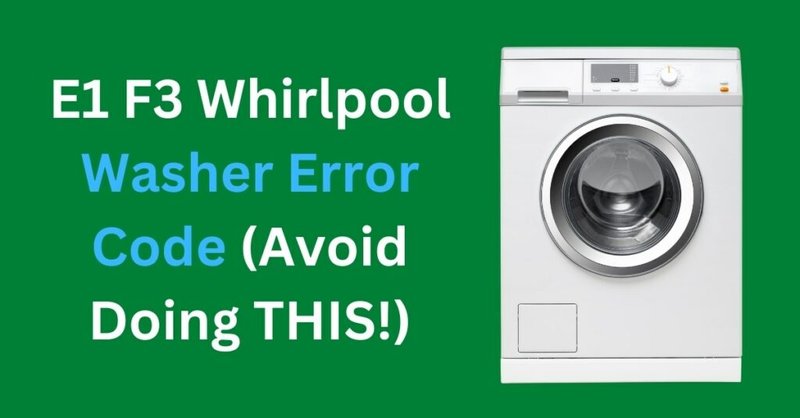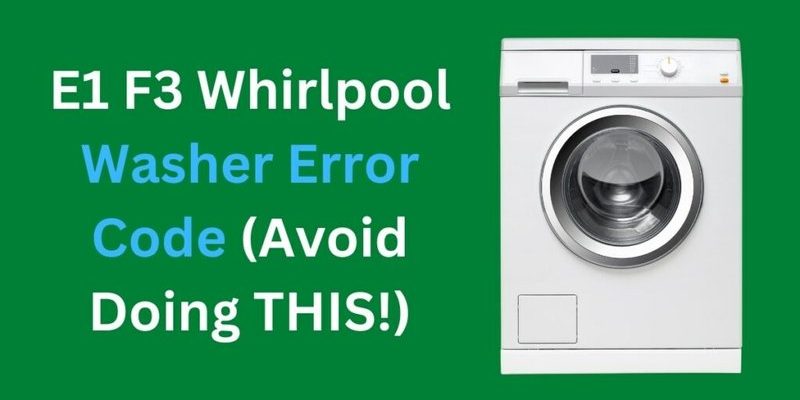
You might be wondering, “Why does this happen, and how can I keep it from happening again?” Imagine your washing machine as a complex piece of machinery that relies on everything running smoothly. When water can’t flow into the machine, like a river being dammed, the machine can’t start its cycle, leading to interruptions and, ultimately, frustration. But don’t worry – with a little knowledge and some preventative care, you can keep your machine humming along happily without showing you that annoying E1 error code.
Understanding the Causes of the E1 Error Code
Here’s the deal: the E1 error code is primarily about water supply issues. Think about how important plumbing is to a house. If water can’t get to where it needs to be, nothing runs as it should. With your washing machine, similar principles apply. The E1 error can occur if there’s a kink in the water hose, if the water inlet valve is clogged or faulty, or even if there’s low water pressure in your home. Each of these issues blocks water from freely entering the machine.
First, imagine the water hoses as the machine’s lifelines. If they’re bent or kinked, water can’t flow through them properly, just like if you bent a straw and tried to drink through it. It’s vital to ensure these hoses are straight and unblocked. Next, consider the water inlet valve – it’s like the gatekeeper of your washing machine. If it’s clogged due to mineral deposits or debris, it needs a thorough cleaning. This is akin to a clogged faucet, and regular maintenance can prevent future blockages.
Lastly, there’s the issue of water pressure. Sometimes, the problem isn’t with the machine at all but with the household water supply. If the pressure is too low, it’s like trying to fill a bucket with a dripping tap – it just takes too long. In such cases, checking for any issues affecting your home’s water pressure or consulting a plumber can be necessary steps to ensure steady water flow.
Regular Maintenance to Prevent E1 Error
Prevention is always better than cure, right? Just like you’d regularly service your car to keep it running smoothly, your washing machine needs some TLC to prevent issues like the E1 error code. Let’s dive into some regular maintenance tips to ensure your machine runs smoothly in the future.
First off, inspect the water hoses regularly. Make it a habit to check them every few weeks to ensure they’re not twisted or damaged. Replace any worn-out hoses, as they might not withstand the water pressure over time. A strong, non-kinked hose is crucial for proper water flow, much like an open highway with no traffic jams.
Next, the water inlet valve should be part of your regular cleaning routine. Over time, mineral deposits can build up, just as they might in your bathroom showerhead. To clean it, turn off the water supply and disconnect the power. Then, gently clean the valve with a brush and some vinegar if necessary to remove any buildup.
Finally, keep an eye on your home’s water pressure. If you notice it’s lower than usual, it might require a professional plumber to take a look. Regularly testing taps and other water outlets in your home can be an early indicator of potential water pressure issues.
What to Do When Faced with an E1 Error
Okay, so you’re standing there, staring at the flashing E1 error code. Don’t panic! It’s just your machine asking for some attention. Here’s what to do next, step-by-step, so you can get back to your regular laundry day.
First, ensure the water supply taps are fully open. It might sound simple, but sometimes we overlook the basics. Check if the water hoses are properly connected and not kinked. If they’re twisted like a pretzel, straighten them out and restart the machine to see if that resolves the issue.
If the hoses are fine, your next step is to check the water inlet valve. Unplug the appliance and turn off the water supply before removing the hoses. Inspect the valve for any signs of blockage or damage. If it’s clogged, a gentle cleaning should do the trick. Once you’ve addressed any blockages, reconnect everything and try running the machine again.
In case these solutions don’t work, it could be time to call a professional. A technician can diagnose more complex problems, such as internal wear and tear, ensuring your machine gets back to perfect working order without the risk of causing further damage.
There you have it! Preventing the E1 error code in your Whirlpool washing machine is all about understanding the causes and performing regular maintenance. Just like tending to a garden prevents weeds from taking over, a little attention here and there can keep your washing machine happily washing away without interruptions.
Remember, keeping an eye on the water hoses, regularly cleaning the inlet valve, and monitoring your home’s water pressure are simple steps that can save you a lot of hassle in the future. By performing these regular checks, you can ensure that your laundry routine flows as smoothly as your favorite song.
So next time you’re about to start a load of laundry, take a moment to check those hoses and valves. Your machine, and your peace of mind, will thank you for it. Through these easy preventative measures, you’ll keep those pesky error codes at bay and your Whirlpool washing machine running like the well-oiled (or rather, well-watered) machine it’s meant to be!
